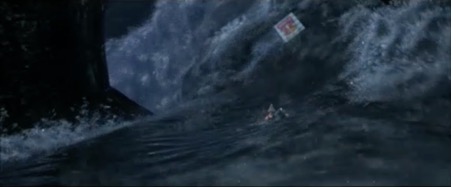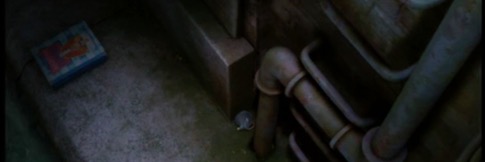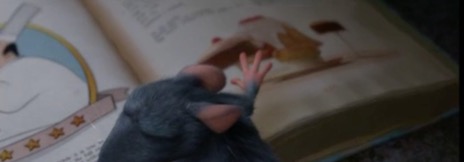Brad Bird’s Ratatouille is a film in which the human community collides with that of the rats, through Remy the rat’s aspiration to be a cook for humans despite his status as animal vermin (assigned to him by those he wishes to cook for). Remy the rat’s first encounter with a compassionate, caring ‘human’ arises from an encounter with a different human intent on his murder: an old woman, from whom he takes a cookbook which contains an illustration of the inspiring human cook Gusteau.

Fig 1: The book ‘leading’ Remy through the treacherous sewers, leading him to the kitchen and the human.
The cookbook in this sequence is a figurative representation of humans, their society and Remy’s own dreams, aspirations and ideas. It reveals a dichotomy of the human world – owned by an ‘evil’ woman who kills rats, it embodies the ‘good’ Gusteau who inspires Remy to cook. This movement of ownership of the book from human to animal is the movement which allows Remy to enter the human world of cooking and culinary delight. Whilst the other rats escape the house via a rehearsed communal manoeuvre on rat-made rafts and boats, Remy is on the ‘human’ cookbook with Gusteau emblazoned on the cover. Remy here has to improvise, rather than follow the rats’ set egalitarian routine, the first mark of the ‘human’ aspect within him which has been revealed. Gusteau, the ‘good’ human, therefore literally carries Remy through the rat environment and human commodity of the sewer to the human environment of the kitchen. Remy, the divergent individual in this equal society, hopes to be a part of the human world and recognised for his culinary talents – a hope which is evident in the bright sky blue of the cookbook’s cover, vivid and radiant in a grey and grim mise-en-scene, otherwise devoid of happiness and hope.

Fig 2: The bright blue of the cookbook in a grimy mise-en-scene.
Whereas the rats’ boats continue their passage to the rat world, the cookbook initiates Remy’s entrance into the human world of cooking, delivering him safely to a pipe that leads to a kitchen. Remy’s movement to this point seems instinctual – choosing to go down one tunnel instead of another, and following the cookbook at all times during a frantic sewer journey (the book is always ahead of him in the mise-en-scene, almost leading him.) Remy’s journey toward the kitchen and therefore the human seems natural and instinctual. The rats continue in the environment of poor hygiene and cleanliness, but instead Remy moves – literally and symbolically – ‘up’ into the gourmet kitchen, where cleanliness and hygiene is an absolute necessity, appropriate for his ‘human’ way of walking – on two legs rather than four paws.
Remy asks for “a sound, a voice, a sign, something” and is answered directly by the cookbook as its illustration of Gusteau becomes animated, a figment of Remy’s imagination. This reigniting of hope is clocked in the soundtrack, a slow, high-pitched and sorrowful score, interrupted by a striking almost-electronic ‘lightbulb’ sound as Gusteau begins to address Remy. The shared love of cooking acts a bridge between animal and human. Gusteau is the only human figure in the film with whom Remy enters into linguistic communication with, the first human who is kind to and accepting of Remy. Gusteau therefore becomes an ideal of the human society which Remy imagines and hopes for. He is only imaginary though, conjured up by Remy, meaning that everything Gusteau says and does is part animal, part human and is further proof of the ‘human’ aspect of Remy.

Fig 3: Remy turning from his animal instincts to the illustration of Gusteau, part of the ‘human’ within him.
The cookbook catalyses Remy’s entrance into the human community because it brings out the ‘human’ in Remy through his imagining of Gusteau. Gusteau answers questions and motivates, but this is actually Remy realising the human aspect within himself, answering his own queries and motivating himself to enter the ‘human’ kitchen and community. This is furthered by the fact Remy turns to the illustration of Gusteau after rejecting one of food on the opposite page – he turns away from one page, from his natural animal instinct of hunger, prompted by the image of cakes, to the opposite page and to Gusteau, who ignites and inspires his ‘human’ instinct of taste infusion and delight.